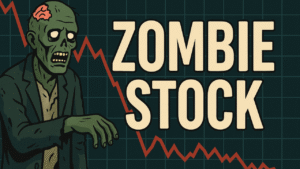 🧟♂️ What Are Zombie Stocks? How to Spot and Avoid Them in Your Portfolio
🧟♂️ What Are Zombie Stocks? How to Spot and Avoid Them in Your Portfolio
In the ever-evolving world of investing, few terms evoke as much caution as “zombie stocks.” These are companies that appear to be alive—still trading, still reporting earnings—but beneath the surface, they’re financially lifeless. Understanding what zombie stocks are, how they operate, and how to avoid them is essential for any investor looking to build a resilient portfolio.
⚠️ What Is a Zombie Stock?
A zombie stock refers to a publicly traded company that survives primarily through borrowing, rather than through sustainable revenue or profit. These companies:
- Generate just enough income to cover interest payments on their debt
- Often lack a viable long-term business model
- Are highly vulnerable to economic shifts, rising interest rates, or investor sentiment
- May continue operating for years without meaningful growth or innovation
They’re called “zombies” because they’re technically alive—but only just. Like their namesake, they shuffle along without real vitality, and any major disruption could send them into financial collapse.
🧮 Key Characteristics of Zombie Stocks
Identifying zombie stocks requires looking beyond surface-level metrics. Here are the most common red flags:
1. High Debt-to-Equity Ratio
Zombie companies often rely heavily on debt to stay afloat. A debt-to-equity ratio above 2.0 may signal excessive leverage, especially if earnings aren’t growing.
2. Negative Free Cash Flow
If a company consistently spends more cash than it generates, it’s likely funding operations through debt or equity dilution—both unsustainable over time.
3. Low or Negative Earnings
Zombie stocks frequently report minimal or negative net income, despite ongoing operations. This suggests poor profitability and weak fundamentals.
4. Low Piotroski F-Score
The Piotroski F-Score is a 9-point scale used to assess a company’s financial health. Scores below 5 often indicate distress and poor operational efficiency.
5. Dependence on Low Interest Rates
Many zombie companies thrive when borrowing is cheap. As interest rates rise, their debt servicing costs balloon—often exposing their fragile balance sheets.
📉 Why Zombie Stocks Are Dangerous for Investors
Holding zombie stocks can be a silent portfolio killer. Here’s why:
- Limited Upside: These companies rarely innovate or grow, meaning share prices stagnate or decline over time.
- High Volatility: Zombie stocks are prone to sudden drops when earnings disappoint or debt becomes unmanageable.
- Dilution Risk: To raise capital, zombie firms may issue new shares—diluting existing shareholders.
- Bankruptcy Exposure: If debt obligations can’t be met, these companies may face restructuring or liquidation.
🔍 How to Spot Zombie Stocks Before You Buy
Before investing, run a quick checklist:
| Metric | Healthy Company | Potential Zombie Stock |
|---|---|---|
| Debt-to-Equity Ratio | < 1.0 | > 2.0 |
| Free Cash Flow | Positive and growing | Negative or declining |
| Net Income | Consistently positive | Negative or erratic |
| Piotroski F-Score | 7–9 | < 5 |
| Interest Coverage Ratio | > 3.0 | < 1.5 |
Use tools like Finviz, Yahoo Finance, or Morningstar to screen for these metrics. If a company checks multiple zombie boxes, it’s best to dig deeper—or walk away.
🧠 Real-World Examples (Without Naming Names)
During periods of low interest rates—such as post-2008 or early pandemic years—many companies took on cheap debt to survive. Airlines, retailers, and energy firms with outdated models became zombie-like: operational, but barely profitable. When rates rose in 2022–2023, many of these firms faced existential threats.
🛡️ How to Protect Your Portfolio
Avoiding zombie stocks isn’t just about screening—it’s about strategy.
- Diversify across sectors and geographies to reduce exposure to any one struggling industry
- Favor companies with strong fundamentals, including consistent earnings, low debt, and positive cash flow
- Use stop-loss orders to limit downside risk if a stock begins to collapse
- Stay informed: Read quarterly reports, listen to earnings calls, and monitor macroeconomic trends
📈 Are Zombie Stocks Ever Worth Buying?
In rare cases, zombie stocks can become turnaround stories. If a company restructures its debt, pivots its business model, or receives a strategic acquisition offer, its stock may rebound. However, these are speculative plays—best left to experienced traders who understand the risks.
🧭 Final Thoughts
Zombie stocks are a cautionary tale in modern investing. They remind us that not all active companies are financially healthy, and that due diligence is essential. By learning to spot the signs of financial decay, investors can avoid dead-end holdings and build portfolios that thrive—not just survive.